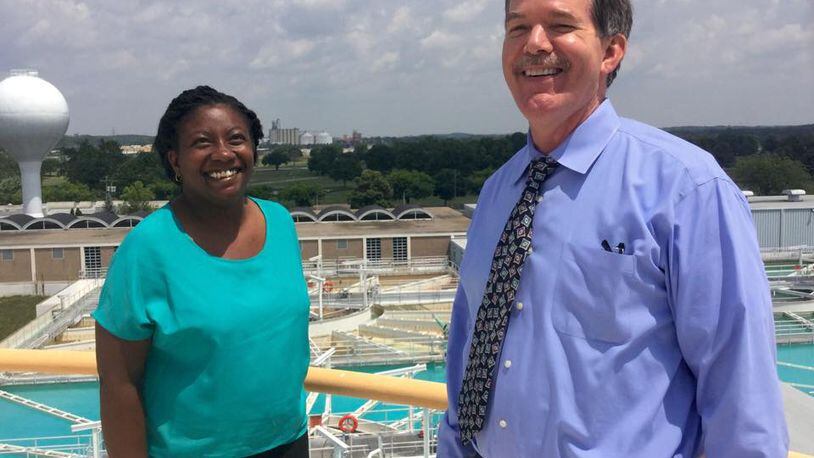"Dayton water is good and plentiful," said Phillip Van Atta, manager of Dayton's Division of Water Supply and Treatment.
Borrowing the water department's slogan, Van Atta called Dayton's water system "regional, reliable and renewable."
I stopped by the city's Chuck Wagner Lane water plant to visit Phillip and Treatment Technical Supervisor Keshia to find out what makes the water here so great.
Naturally good
Credit: Amelia Robinson
Credit: Amelia Robinson
First, here is a little background.
Formed thousand of years ago by glaciers and located under the Great Miami River, the aquifer is recharged by rain and other precipitation.
Roughly 250 feet deep, it stretches from Logan County to the Ohio River, according to the Journal-News.
Its water flows between the sediment particles.
Why it tastes good
Credit: Amelia Robinson
Credit: Amelia Robinson
Phillip says Dayton's water doesn't have problems associated with water systems that use surface water and thus isn't impacted by super stinky organic compounds like geosmin.
"It naturally tastes good," Philliip said of our water. "We don't have the taste and odor problems surface water has because of algae."
As Phillip points out, taste is a subjective thing, but come on, Dayton water is a source of pride.
How good the water tastes often comes in normal conversation in these parts and can be a sought-after commodity.
Out-of-town friends of Phillip's sister routinely fill containers up with Dayton water to take home.
City workers routinely passes out bottles of Dayton water at festival and other community events.
It's protected
Phillip said the city started developing its ground water protection program in the early '80s in recognition of a chemical dumping and landfill linked contamination at places like Sunny Acres Mobile Home Park.
People are passionate about what here and a proposal that would change how Dayton regulates businesses that fall under the city’s protection program has many concerned.
A group called the "Dayton Citizens Water Brigade" has an online petition.
Tested and backed up
The city has 17 strategically placed air stripper towers that work to remove volatile organic compounds that may cause cancer, Phillip says.
Tens of thousands of water purity and quality tests are completed each by plant operators and water quality scientists.
Credit: Amelia Robinson
Credit: Amelia Robinson
Dayton has a wastewater treatment facility and two water plants. One is near Kitty Hawk Golf Course on Chuck Wagner Lane, the other is on Ottawa Street.
Either can provide treated drinking water to the entire system in emergencies, according to Phillip.
He said the city separated its stormwater sewer system from its sanitary sewer system in the late 1800s to help prevent flooding and overflow problems.
Cincinnati is spending $3 billion on new construction that will address overflow of raw sewage and stormwater in water ways and home.
Bright blue lagoon
Credit: Amelia Robinson
Credit: Amelia Robinson
About 23,000 tons of calcium oxide (quick lime) are produced each year at the the city's lime reclamation facility next to the Ottawa Water Treatment Plant. It is the strange bright blue lake you see from Route 4.
Dayton uses the quick lime partly to remove minerals from the water softening. It also sells it to eight other water systems in Ohio — Hamilton, Wyoming, Middletown, Troy, Piqua, Ottawa, Defiance and Glendale.
Besides the recycled lime, the city also uses fluoride and chlorine as part of the treatment process. Rapid sand filtration is the last step before it is sent to pumps and homes.
Back to that blue lagoon. Oddly enough, the water department has recycled lime softening residuals from the water treatment process since 1957. Before then, residuals were stored in lagoons.
Dayton water gets around
Dayton provides water to much of Montgomery County — Centerville, Kettering, Moraine, Harrison Twp., Butler Twp., Riverside, Brookville, Greenville, Trotwood and parts of Clayton included — directly or through a contract with Montgomery County.
Englewood and Huber Heights are among the local communities with their own water systems using the aquifer.
Dayton water by the numbers
$16 million — the amount the city spends annually to replace aging water and sewer pipelines.
More than 750 miles — length of water distribution pipelines
Three — number of well fields with more than 100 wells
21,000 — the number of catch basins
15,000 — the number of manholes.
88 million gallons
— the capacity of water storage in 16 tanks and reservoirs
23 billion gallons — the amount of treated drinking water the city pumped in 2014.
Credit: Amelia Robinson
Credit: Amelia Robinson
About the Author
